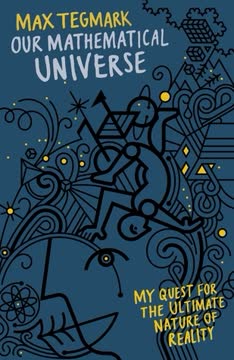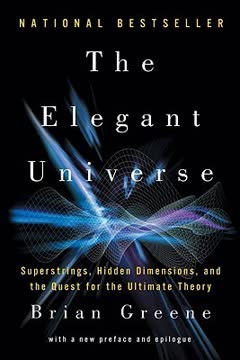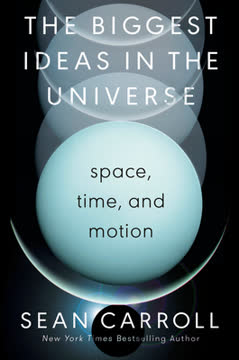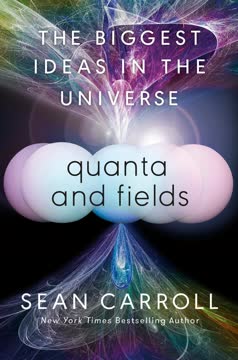Key Takeaways
1. The universe is governed by impersonal laws of physics
The universe doesn't need a push; it can just keep going.
Fundamental nature of reality. The Core Theory, encompassing quantum field theory and general relativity, provides a comprehensive description of the particles and forces that make up our everyday world. This theory explains how the universe operates without any external guidance or purpose, following patterns that connect different moments in time.
Conservation principles. Two key concepts underpin this understanding:
- Conservation of momentum: Objects in motion tend to stay in motion without needing a constant "mover"
- Conservation of information: The current state of the universe contains all the information needed to determine its past and future states
These principles eliminate the need for supernatural explanations and allow us to understand the universe as a self-contained system operating according to natural laws.
2. Consciousness emerges from complex physical processes
Consciousness isn't an illusion, but it doesn't point to any departure from the laws of physics as we currently understand them.
Emergent phenomenon. Consciousness arises from the complex interactions of neurons in the brain, without requiring any additional non-physical substance or property. This view, known as physicalism, argues that our subjective experiences, thoughts, and feelings are ways of talking about the behavior of physical systems.
Key aspects of consciousness:
- Awareness of self and environment
- Information processing and integration
- Ability to form mental representations and plan for the future
- Subjective experiences (qualia)
While we don't yet have a complete understanding of consciousness, current neuroscience research supports the idea that it can be explained within the framework of physical laws, without invoking mystical or supernatural elements.
3. Life arises from simple chemical reactions and natural selection
There is no reason to think that we won't be able to figure out how life started.
Chemical origins. Life likely began with self-replicating molecules, such as RNA, forming in conditions present on the early Earth. These molecules could store information and catalyze their own reproduction, setting the stage for evolution.
Key steps in the origin of life:
- Formation of organic molecules
- Development of self-replicating systems
- Encapsulation within membranes
- Emergence of metabolism
- Evolution of more complex organisms
Natural selection then acted on these early life forms, favoring those that were better at surviving and reproducing. This process, operating over billions of years, led to the diverse array of life we see today, including complex organisms like humans.
4. Our understanding of reality is shaped by multiple perspectives
There is only one world, the natural world, but many useful ways of talking about it.
Poetic naturalism. This philosophical approach recognizes that while there is a single underlying reality governed by physical laws, we can describe it using multiple "stories" or models. Each of these stories captures different aspects of reality and is useful within its domain of applicability.
Levels of description:
- Fundamental: Quantum fields and particles
- Emergent: Atoms, molecules, cells, organisms
- Higher-level: Psychology, sociology, economics
These different levels are not in conflict but represent complementary ways of understanding the world. We can choose the most appropriate level of description based on the question we're trying to answer, while recognizing that all levels ultimately emerge from the fundamental physical reality.
5. The arrow of time explains the emergence of complexity
The origin of time's arrow is ekinological: it arises from a special condition in the far past.
Entropy and complexity. The second law of thermodynamics states that the entropy (disorder) of an isolated system always increases over time. This provides a direction to time and explains why we remember the past but not the future.
Paradoxically, the increase in entropy allows for the temporary emergence of complex structures:
- Early universe: Low entropy, simple, and uniform
- Current era: Medium entropy, complex structures like galaxies, stars, and life
- Far future: High entropy, simple and uniform again
The arrow of time, arising from the low-entropy state of the early universe, is crucial for understanding phenomena like causality, memory, and the emergence of life and consciousness.
6. Free will is compatible with deterministic laws of physics
Our best theories of people, presented on their own terms and without reference to underlying particles and forces, leave plenty of room for human choice.
Compatibilism. While the fundamental laws of physics are deterministic, this doesn't negate the concept of free will. Free will is better understood as a higher-level description of human decision-making processes, compatible with the underlying physical laws.
Key points:
- Decisions emerge from complex neural processes
- We can't predict our own future actions with certainty
- The feeling of making choices is real and important
- Moral responsibility is based on this higher-level description
This view allows us to reconcile our intuitive sense of having choices with the deterministic nature of physical laws, preserving both scientific understanding and human agency.
7. Meaning and purpose are human constructs in a purposeless cosmos
Purpose and meaning in life arise through fundamentally human acts of creation, rather than being derived from anything outside ourselves.
Creating meaning. In a universe without inherent purpose, humans have the freedom and responsibility to create their own meaning and values. This perspective, often associated with existentialism, emphasizes human agency in determining what is important and worthwhile.
Approaches to finding meaning:
- Personal relationships and love
- Creative pursuits and self-expression
- Contributing to society or a cause
- Pursuit of knowledge and understanding
- Personal growth and self-improvement
While the universe itself may be indifferent, our ability to create meaning allows us to lead fulfilling and purposeful lives within the natural world.
8. Science progresses through Bayesian reasoning and evidence
Science should be interested in determining the truth, whatever that truth may be—natural, supernatural, or otherwise.
Bayesian inference. Scientific progress occurs through the continuous updating of our beliefs based on new evidence. This process, formalized in Bayesian statistics, involves:
- Starting with prior probabilities for different hypotheses
- Collecting new data
- Updating our beliefs based on how well the data fits each hypothesis
Key principles:
- All beliefs should be held with some degree of uncertainty
- Evidence can increase or decrease our confidence in a hypothesis
- Simple theories are generally preferred over complex ones
This approach allows science to be self-correcting and to converge on increasingly accurate descriptions of reality over time.
9. Quantum mechanics reveals the probabilistic nature of reality
Quantum mechanics tells us the probability that, upon observing a quantum system with a specified wave function, we will see any particular outcome.
Fundamental uncertainty. At the quantum level, reality is described by wave functions that represent probabilities rather than definite states. This leads to counterintuitive phenomena such as:
- Superposition: Objects can exist in multiple states simultaneously
- Entanglement: Particles can be correlated over large distances
- Wave-particle duality: Matter and energy exhibit both wave-like and particle-like properties
Interpretations of quantum mechanics:
- Copenhagen interpretation: Measurement causes wave function collapse
- Many-worlds interpretation: All possible outcomes occur in separate branches of reality
- Pilot wave theory: Particles have definite positions guided by a wave function
While the interpretation of quantum mechanics remains debated, its mathematical framework has been extremely successful in describing the behavior of matter at the smallest scales.
10. The multiverse may explain fine-tuning and the existence of life
If we live in a world where conditions are very different from place to place, then there is a strong selection effect on what we will actually observe about that world: we will only ever find ourselves in a part of the world that allows for us to exist.
Anthropic reasoning. The apparent fine-tuning of physical constants for life may be explained by the existence of a vast multiverse containing regions with different laws and constants. In this scenario, we naturally find ourselves in a region compatible with our existence, without requiring a designer or special purpose.
Types of multiverse theories:
- Inflationary multiverse: Different regions of space with varying physical laws
- String theory landscape: Multiple ways to compactify extra dimensions, leading to different effective laws
- Many-worlds interpretation of quantum mechanics: All possible outcomes realized in separate branches
While speculative, these ideas provide potential naturalistic explanations for the existence of life and the apparent fine-tuning of our universe, without resorting to supernatural explanations.
Last updated:
FAQ
What's The Big Picture about?
- Exploration of Existence: The Big Picture by Sean Carroll explores the origins of life, meaning, and the universe itself, combining insights from physics, philosophy, and biology.
- Naturalism Focus: Carroll advocates for a naturalistic worldview, explaining that everything we experience can be understood through the laws of nature without supernatural elements.
- Interconnected Themes: The book is structured into six parts, each addressing different aspects of reality and human experience, emphasizing the importance of both fundamental laws and emergent properties.
Why should I read The Big Picture?
- Comprehensive Framework: The book provides a coherent framework for understanding the universe and our place within it, making complex scientific concepts accessible.
- Engaging Writing Style: Sean Carroll's engaging and thought-provoking writing style invites readers to ponder deep questions about life and existence.
- Encourages Critical Thinking: It challenges conventional views and promotes a scientific approach to understanding the world, encouraging readers to think critically about their beliefs.
What are the key takeaways of The Big Picture?
- Naturalism as a Foundation: Carroll argues for a naturalistic worldview, emphasizing that everything we experience is part of a single, unified reality governed by natural laws.
- Emergence of Complexity: The book discusses how complex systems, including life and consciousness, emerge from simpler components, highlighting the dynamic nature of existence.
- Meaning and Values: Meaning and values are human constructs arising from our interactions with the world, not transcendent but still meaningful.
What is poetic naturalism in The Big Picture?
- Definition of Poetic Naturalism: Poetic naturalism combines naturalism with the recognition of multiple ways to talk about the world, each capturing different aspects of reality.
- Emergent Properties: This approach acknowledges emergent properties like consciousness and social interactions as real and meaningful, even if not part of the fundamental description of reality.
- Compatibility of Theories: Poetic naturalism asserts that different theories can coexist and provide valuable insights into the same underlying reality.
How does The Big Picture address the concept of consciousness?
- Consciousness as Emergent: Carroll explores consciousness as an emergent property of complex systems, arising from the interactions of simpler components.
- Philosophical Implications: The book discusses the challenge of reconciling subjective experiences with a physicalist worldview, engaging with the "hard problem" of consciousness.
- Rejection of Dualism: Carroll argues against dualistic interpretations, emphasizing that consciousness should be understood as part of the natural world.
What does The Big Picture say about the nature of reality?
- Unified Reality: Carroll asserts that reality is unified and operates according to natural laws, rejecting the notion of a separate supernatural realm.
- Ontology and Epistemology: The book distinguishes between what exists and how we know what exists, emphasizing the importance of understanding both.
- Emergence of Meaning: Meaning and purpose emerge from human experiences and interactions, rather than being inherent in the universe.
How does The Big Picture explain quantum mechanics?
- Wave Function Concept: Carroll explains that particles exist in a state of superposition, represented by a wave function encompassing all possible outcomes.
- Observer Effect: The book discusses the measurement problem, where observation causes the wave function to collapse into a specific outcome.
- Quantum Probability: Quantum mechanics operates on probabilities rather than certainties, meaning outcomes can only be predicted probabilistically.
How does The Big Picture relate entropy to the emergence of complexity?
- Entropy and Time: Carroll discusses how entropy provides an arrow of time, allowing for the emergence of complex structures.
- Complexity from Disorder: While entropy increases, complexity can emerge during the transition from low to high entropy.
- Self-Organization: Self-organization occurs in open systems, where energy and information exchange can lead to complex structures.
How does The Big Picture address the origin of life?
- Abiogenesis: Carroll explores abiogenesis, the process by which life arises from non-living matter, governed by physics and chemistry.
- Key Features of Life: The book identifies compartmentalization, metabolism, and replication with variation as key features of life.
- Environmental Conditions: Specific conditions, like those in hydrothermal vents, may have facilitated the emergence of life.
How does The Big Picture challenge traditional views of purpose and meaning?
- Purpose as Construct: Carroll posits that purpose is not inherent but a construct emerging from our understanding of complex systems.
- Naturalism Perspective: Meaning and purpose are derived from experiences and relationships, not dictated by external forces.
- Human Agency: Humans have the capacity to create their own meaning and purpose through actions and choices.
What is the relationship between science and morality in The Big Picture?
- Constructed Morality: Carroll argues that moral values are constructed by humans, not derived from scientific facts.
- No Objective Morality: Scientific descriptions do not dictate moral imperatives; moral reasoning requires reflection and dialogue.
- Practical Ethics: While subjective, morality can be guided by principles promoting well-being and reducing suffering.
How does The Big Picture explain the concept of meaning in life?
- Subjective Creation: Meaning is created by individuals through choices and relationships, not inherent in life.
- Caring and Connection: Caring about others and the world is fundamental to creating meaning.
- Embracing Change: Life's impermanence adds depth to experiences, allowing meaning to be found in the journey.
Review Summary
The Big Picture receives mostly positive reviews, praised for its ambitious scope covering science, philosophy, and the meaning of life. Readers appreciate Carroll's clear explanations of complex topics and his "poetic naturalism" worldview. Some find the book too long or philosophically dense, while others enjoy its thought-provoking ideas. Critics note it may be challenging for those without a science background. Overall, reviewers commend Carroll's engaging writing style and ability to connect scientific concepts to everyday life, though opinions vary on the book's effectiveness in addressing existential questions.
Similar Books










Download PDF
Download EPUB
.epub digital book format is ideal for reading ebooks on phones, tablets, and e-readers.








